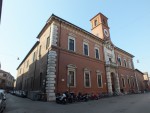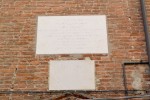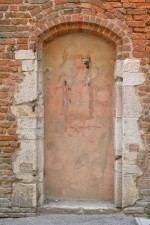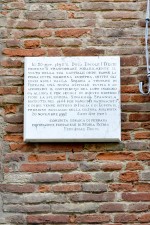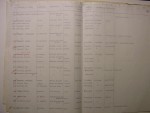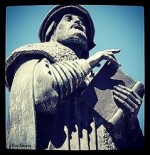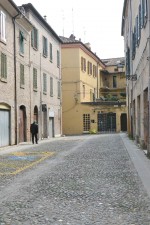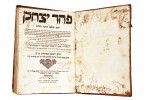Medicina
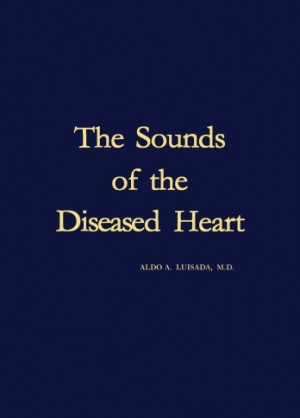
Cover by Aldo A. Luisada, The Sound of the Diseased Heart, St. Louis, Warren H. Green, 1973 (reprint 2013 Butterworth-Heinemann)
Ferrara is one of the world capitals of Jewish medical science.
1. Under the Este
The name of Nathan ha Meati, translator of Avicenna and Hippocrates and Jewish doctor from the late 13th century, can be traced to the beginnings of Jewish medicine in Ferrara.
In the Este era, Jews excelled in medical science, also because it was the only doctorate allowed to them, as medicine was considered a field of study unrelated to religion, and therefore also practicable by non-Christians. To obtain their degree, Jews had to obtain a papal dispensation (except in rare cases in which they act in derogation of this provision) and pass, like Christians, a very hard examination. In the 15th and 16th centuries, there were reports of Jews obtaining the title of artium et medicinae doctor at the University of Ferrara, founded in 1391 by Alberto V d'Este (1347-1393). When, on 25 July 1467, the future Duke Ercole I d'Este (1431-1505) was seriously injured in the right foot malleolus during the battle of Riccardina (or Molinella), near Bologna, fighting against the Florentines, once he returned to Ferrara he was treated by a Jewish doctor (Ercole, however, remained lame throughout his life and was called by the Venetians Il ciotto, or "The cripple"). The University of Ferrara also included among its graduates the famous philosopher and biblical exegete Obadià Sforno (about 1470-1550), who obtained the title of doctor in 1501. The Portuguese Jewish physician Amato Lusitano (1511-1568), who graduated in Salamanca, stayed in Ferrara for seven years, from 1541 to 1547, teaching Botany and Anatomy at the University.
2. The ghetto
With the construction of the ghetto in 1627, under papal rule, the Jews were progressively deprived of their rights, leading to the edict of Bishop Cardinal Magalotti in 1629 which, in addition to introducing coercive preaching in the Ducal Chapel, forbade Christians to assist sick and dying Jews, and vice versa, Jewish doctors and surgeons to treat and teach medical art to Christians, despite the fact that it is known that Christians themselves have always had great faith in Jewish medical science.
Isacco Lampronti (1679-1756), a famous doctor and philosopher from Ferrara, graduated in Padua, but it was in Ferrara, in his home in the ghetto, that he returned in 1701, when he was awarded the title of rabbi.
3. The 20th century and racial persecution
The Jewish doctors Cesare Tedeschi and Aldo Augusto Luisada, who taught histopathology and pathophysiology at the University of Ferrara, respectively, were expelled from teaching following the racial laws of 1938 and found refuge in the United States. Maria Zamorani (1893-1944), a paediatrician and researcher at the Sant'Anna hospital, appeared among the last names on the plaque in Via Mazzini: her life ended in 1944 in the Auschwitz extermination camp, Poland.
4. Quotes
"1446, 5 September, Ferrara
Anna, Jewish daughter of the late Solomone, inhabitant with Maestro Elia Jewish doctor from Fermo in the district of San Salvatore, constituted Rinaldo Mezzaprili her prosecutor in the case that she had with Moses, Jewish lender in Ravenna, expressly to have him imprisoned, as his debtor on suspicion of flight". (Regesto di Franceschini 2007, Doc. 476, p. 175)
"There was also a valiant surgeon in 1467, who also had a lot of shouting in the House of Este Court.
In fact, when Ercole I was wounded in that year, after having fought valiantly in the Bolognese plain against the Florentine army, putting it on the run, he was brought back to his capital to be treated there. His injury was severe and to the collarbone of his right foot. Arrived in Ferrara, ‘there he found rest in the care of Jacob the Jew’, so we like to call him Frizzi (vol. IV, p. 62). So, he recovered, remaining lame for the rest of his life, due to the nature of the injury received". (Pesaro 1878-1880, p. 14)
"An Edict of the Bishop Cardinal Magalotti of 1629 added other very serious [prohibitions] [...] Christian doctors and surgeons were not allowed without a license to come to the aid of Jewish nurses and the sick, and Jewish doctors, surgeons and teachers were forbidden to treat and teach Christians, and Christian teachers to instruct Jews". (Pesaro 1878-1880, pages 42-43)
"We want to talk about Isaac Lampronti, whom humanity and the homeland can well honour, and who in our opinion was the most distinguished character that this Israeli Community has had. [...] he went to Padua to take the medical course [...] As he had obtained the Diploma in Medicine with great honour, before returning to his native city he stayed in various others on the peninsula [...] Returning to Ferrara he was received with many honours. The Rabbinical Academy, which was very flourishing and in close relationship with the most important ones in Italy, conferred on him the title of Haver, and admitted him among its distinguished members, although he was very young". (Pesaro 1878-1880, pages 54-55)
Bibliography
- Pesaro, Abramo, Memorie storiche sulla Comunità israelitica ferrarese, rist. anast. dell'edizione Ferrara 1878-1880, Forni, Sala Bolognese (Bologna) 1986
- Muzzarelli, Maria Giuseppina, Gli Ebrei, in Bocchi, Francesca (a cura di), Storia illustrata di Ferrara, Vol. II, AIEP, Repubblica di San Marino 1987, pp. 465-480
- Franceschini, Adriano, Presenza ebraica a Ferrara. Testimonianze archivistiche fino al 1492, Olschki, Firenze 2007
- Associazione De Humanitate Sanctae Annae (a cura di), Medici ebrei e la cultura ebraica a Ferrara, Faust, Ferrara 2014
Sitography
Archival Sources
- Archivio di Stato di Ferrara, Archivio Notarile Antico di Ferrara, not. Antonio Fontacchiesi, matr. 66, pacco 1, schede 1446
Related places
Related Themes
Related Subjects
Related Objects
Compiling entity
- Istituto di Storia Contemporanea di Ferrara
Author
- Edoardo Moretti
- Sharon Reichel

